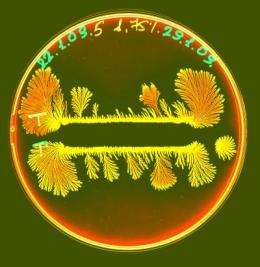Colonies of bacteria fight for resources with lethal protein

Rival colonies of bacteria can produce a lethal chemical that keeps competitors at bay, scientists report this week. By halting the growth of nearby colonies and even killing some of the cells, groups of bacteria preserve scarce resources for themselves, even when the encroaching colony is closely related.
"It supports the notion that each colony is a superorganism, a multicellular organism with it's own identity," said Eshel Ben-Jacob, an adjunct senior scientist at UC San Diego's Center for Theoretical Biological Physics and professor of physics at Tel Aviv University. Ben-Jacob and lead author Avraham Be'er of the University of Texas, Austin, and other colleagues at these institutions report their discovery in the early online edition of the Proceedings of the National Academy of Sciences.
Alone in a dish, colonies of the bacterium Paenibacillus dendritiformis will send branches of cells in all directions. But when forced to share a plate of limited nutrients with another colony, the branching patterns of both colonies become lopsided, leaving a space between the two.
It's not a lack of food that halts the growth. The researchers found nutrients in the gap, but they also found a protein there that wasn't present elsewhere on the dish. When they dabbed a bit of the purified protein on a fresh dish inoculated with P. dendritiformis, the bacteria formed a lopsided colony that shied away from the spot. And the cells at the edge of the colony closest to the suspect protein were dead.
They named the protein "sibling lethal factor," for its ability to kill even closely related colonies derived from a single original colony, and identified its gene. But the gene made a protein that was too large, heavier that the lethal factor by two-thirds and harmless. They concluded that some other factor must be in play.
Rather than guess, or poke about experimentally to figure out what was going on, Ben-Jacob and his colleagues created a model to guide their thinking.
"In physics, we use models to make predictions," Ben-Jacob said, noting that biological models often present what is already understood. The model told them that they should be looking for something that would prune the full-size factor to its smaller lethal form as the colonies began to compete, a factor that might be harmless or even helpful until it reached a certain threshold.
P. dendritiformis also secretes a protein called subtilisin, which promotes growth, except in high concentrations. Subtilisin, which was already known and is available commercially, clipped the full-sized protein to the size of that found between competing colonies. This smaller piece slices the bacteria cells open and spills their contents into the medium, they found.
"Very often, you discover that in order to explain what's going on, you need to imagine mechanisms that are beyond what the biologists have specifically discovered about the system," said Herbert Levine, a physics professor at UC San Diego who co-directs the Center for Theoretical Biological Physics, but was not involved in this study. "In this work, they've succeeded in taking the next step," he said. "They were able find the chemical messenger that is actually playing the role they hypothesized."
Provided by University of California - San Diego

















